New Zealand is a land of breathtaking landscapes and rich history, offering visitors a unique opportunity to explore its past through a variety of heritage trails. From ancient Maori settlements to colonial outposts, these trails invite you to walk through the narratives that have shaped the nation. In this blog, we will delve into some of New Zealand’s most captivating heritage trails, highlighting their historical significance, natural beauty, and tips for making the most of your journey.
The Significance of Heritage Trails

Heritage trails serve as living museums, allowing visitors to engage with the cultural and historical aspects of a region. They connect people to the land, showcasing the stories of its original inhabitants, early explorers, and settlers. Walking these trails fosters a deeper understanding of New Zealand’s diverse history and the relationship between its people and their environment.
Iconic Heritage Trails to Explore
1. The Tongariro Alpine Crossing

Overview
Often referred to as the “best day hike in New Zealand,” the Tongariro Alpine Crossing is more than just a stunning trek through volcanic landscapes; it is steeped in cultural significance. Located in Tongariro National Park, this trail is a dual UNESCO World Heritage Site, recognized for both its natural and cultural values.
Historical Significance
The area is sacred to the Maori, particularly the Ngāti Tūwharetoa tribe. The mountains, including the iconic Mount Tongariro, are central to their creation stories and hold deep spiritual significance. The trail traverses various geological features, including craters, thermal pools, and emerald lakes, each telling a part of the land’s history.
What to Expect
- Distance: 19.4 kilometers (12 miles)
- Time: 6-8 hours to complete
- Terrain: Volcanic rock, steep inclines, and breathtaking views.
Tip: Start early in the morning to avoid crowds and take advantage of the changing light over the landscape. Be sure to check the weather, as conditions can change rapidly.
2. The Old Ghost Road
Overview
The Old Ghost Road is a 85-kilometer (53 miles) trail that retraces the historic route used during the gold rush era of the late 1800s. This remote trail is located in the rugged Southern Alps, offering a blend of history, adventure, and stunning scenery.
Historical Significance
Originally constructed as a road to access goldfields, the trail has since fallen into disuse, earning its “ghost” moniker. Today, it stands as a tribute to the resilience of early miners and settlers. Along the trail, you’ll find remnants of the past, including old mining sites and ghostly relics of the original road.
What to Expect
- Distance: 85 kilometers (53 miles) one way
- Time: 3-5 days for a complete traverse
- Terrain: Varied, including river crossings, steep climbs, and dense forest.
Tip: Plan for an overnight stay in one of the huts along the trail, and take your time to explore the history and natural beauty around you.
3. The Whanganui River Road

Overview
The Whanganui River Road offers a unique way to experience the cultural heritage of the Whanganui region. Following the river’s banks, this trail is an integral part of the area’s historical landscape and is often referred to as the “River of Falling Waters.”
Historical Significance
The Whanganui River holds deep spiritual significance for the local iwi (tribes), including the Whanganui iwi. It has been a vital resource for transportation, food, and culture for centuries. The trail features numerous sites of historical importance, including old settlements and sacred sites.
What to Expect
- Distance: Approximately 145 kilometers (90 miles) along the river
- Time: Varies depending on the chosen route and stops
- Terrain: Mostly flat, with occasional hills and riverbank paths.
Tip: Consider a guided kayak trip down the river, which offers a different perspective on the historical sites and stunning scenery.
4. The Otago Central Rail Trail

Overview
This 150-kilometer (93 miles) trail follows the route of the historic Otago Central Railway, linking the towns of Clyde and Middlemarch. It offers a scenic journey through the heart of Central Otago, showcasing both natural beauty and historical landmarks.
Historical Significance
Opened in the late 19th century, the railway played a crucial role in the region’s development, facilitating the movement of goods and people during the gold rush. The trail today features numerous information panels that tell the story of the railway and the communities it served.
What to Expect
- Distance: 150 kilometers (93 miles)
- Time: Typically completed in 3-5 days
- Terrain: Flat with some gentle hills, suitable for biking and walking.
Tip: Stop in the charming towns along the way to sample local cuisine and learn about the gold mining history.
5. The Marlborough Sounds Heritage Trail

Overview
The Marlborough Sounds Heritage Trail offers a captivating combination of natural beauty and historical exploration. Spanning over 70 kilometers (43 miles), this trail winds through lush forests, along rugged coastlines, and across ancient Maori pathways.
Historical Significance
The Marlborough Sounds are rich in Maori history, with numerous significant sites that tell the story of the region’s early inhabitants. The area was also an important whaling center in the 19th century, and remnants of this history can be found along the trail.
What to Expect
- Distance: 70 kilometers (43 miles) with various loop options
- Time: 2-5 days, depending on the route
- Terrain: Varied, with coastal tracks and forest paths.
Tip: Take time to explore the side trails leading to historical sites and viewpoints.
Practical Tips for Walking Heritage Trails
- Research Before You Go: Understanding the history and cultural significance of the trails will enhance your experience. Read up on the local iwi (tribes) and their stories.
- Pack Wisely: Bring plenty of water, snacks, and appropriate gear. Weather in New Zealand can change rapidly, so dress in layers and be prepared for rain.
- Leave No Trace: Respect the environment by following Leave No Trace principles. Stay on marked paths and dispose of waste responsibly.
- Engage with Local Communities: Take the time to connect with local communities. Many iwi and local artisans offer guided tours and cultural experiences that can enrich your understanding of the area.
- Consider Guided Tours: For a more in-depth experience, consider joining guided heritage walks. Knowledgeable guides can provide valuable insights into the history and culture of the region.
Conclusion
Walking through New Zealand’s heritage trails is an unforgettable way to connect with the country’s rich history and diverse landscapes. Each trail offers a unique journey, revealing stories of its people, culture, and environment. Whether you’re trekking the volcanic landscapes of Tongariro or exploring the historic paths of the Old Ghost Road, you’ll find that these trails are more than just routes; they are narratives etched into the land.
So lace up your hiking boots, grab your camera, and embark on an adventure that will leave you with a deeper appreciation for New Zealand’s heritage and the beauty of its historical landscapes. Happy trails!












